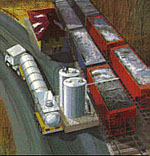Industrial De-Icing Systems
Winter Use Spraying Systems
Whether treating rail cars or bulk material moving on conveyors, calcium chloride has proven invaluable when cold temperatures combine with moisture to freeze processing materials.
A properly
designed system customized for your unique needs
combined with the proper strength of calcium
chloride and most efficient application rate can
virtually eliminate freeze-ups due to mother
nature.
Included in
Pollard systems are various storage
alternatives, and pumping, spraying and control
equipment. Each system must be designed
and evaluated in respect of your specific
requirements.
The movement
of bulk materials such as coal, crushed stone,
gravel and sand from rail cars and conveyors is
made much more difficult when they are frozen.
Calcium chloride, in actual use, has proven
effective as a freeze-resisting and thawing
agent.

Benefits associated with its use are:
-Improved material flow
-Decreased unloading times resulting in:
Lower labor costs
Lower hopper car
demurrage costs
Less tie-up of cars and
rail sidings
-Reduced hopper car damage by:
Minimizing car shaking
Elimination of explosives
as a means of loosening materials
-Less damage to crushing equipment:
Less production down time
Studies have
been made to determine the corrosive effect of
calcium chloride on the cars. Twenty rail
cars were assigned in dedicated service to
supply coal from Western Pennsylvania to a
production facility. Thickness readings
were taken on 12 points of each car's slope
sheets prior to beginning the tests. From
October 1979 to April 1980, approximately 1.2
imperial gallons of 32% calcium chloride
solution per ton of coal was sprayed into the
car, half on the walls and bottom prior to
loading and the remainder during loading.
A second set
of thickness readings was taken in April and no
further applications of calcium chloride were
made until October 1980 when a third set of
reading was obtained.
Tests results based on these readings are as
follows:
|
Average Corrosion/Erosion Rate in Mils |
6-Month Test Period |
Annualized |
Calcium chloride treatment |
0.8 |
1.6 |
No treatment |
4.3 |
8.6 |
As is readily apparent from these data, corrosion/erosion rates were actually higher without treatment than with treatment.
There are two reasons which may have accounted for this: greater moisture in summer cold and warm temperatures, which are factors known to increase corrosion.
Nonetheless, the conclusion is clear: calcium chloride used
according to the test conditions does not markedly contribute to hopper car corrosion rates.
There may be applications, however, that are
sensitive to corrosion. Pollard has
responded to these situations with it's
Corrosion-Reduced Calcium chloride product line.
Storage System Supplied By Pollard Highway
Products

|
